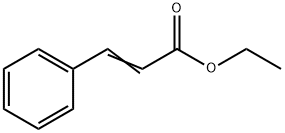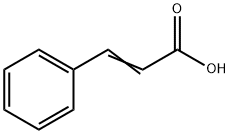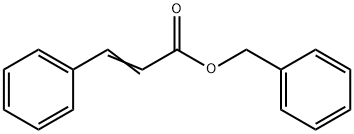A3946712
Ethyl cinnamate , 99% , 103-36-6
Synonym(s):
3-Phenyl-2-propenoic acid ethyl ester;Ethyl 3-phenyl-2-propenoate;Ethyl cinnamate;Ethyl trans-3-phenylpropenoate, Cinnamic acid ethyl ester;NSC 6773
CAS NO.:103-36-6
Empirical Formula: C11H12O2
Molecular Weight: 176.21
MDL number: MFCD00009189
EINECS: 203-104-6
| Pack Size | Price | Stock | Quantity |
| 25ml | RMB38.40 | In Stock |
|
| 100ML | RMB87.20 | In Stock |
|
| 500ML | RMB302.40 | In Stock |
|
| 2.5L | RMB1380.00 | In Stock |
|
| others | Enquire |
Update time: 2022-07-08
PRODUCT Properties
| Melting point: | 6-8 °C (lit.) |
| Boiling point: | 271 °C (lit.) |
| Density | 1.049 g/mL at 20 °C (lit.) |
| vapor pressure | 6Pa at 20℃ |
| FEMA | 2430 | ETHYL CINNAMATE |
| refractive index | n |
| Flash point: | >230 °F |
| storage temp. | 2-8°C |
| solubility | Soluble in Chloroform,Dichloromethane,Ethyl Acetate,DMSO,Acetone,etc. |
| form | Liquid |
| color | Clear colorless to pale yellow |
| Odor | at 100.00 %. sweet balsam fruity spicy powdery berry plum |
| Odor Type | balsamic |
| biological source | synthetic |
| Water Solubility | insoluble |
| Merck | 14,2299 |
| JECFA Number | 659 |
| BRN | 1238804 |
| Dielectric constant | 5.3(19℃) |
| Stability: | Stable. Incompatible with strong oxidizing agents, acids, bases, reducing agents. Combustible. |
| LogP | 3.01 at 23.6℃ |
| CAS DataBase Reference | 103-36-6(CAS DataBase Reference) |
| NIST Chemistry Reference | trans-Ethyl cinnamate(103-36-6) |
| EPA Substance Registry System | Ethyl cinnamate (103-36-6) |
Description and Uses
Ethyl cinnamate is the ester of cinnamic acid and ethanol, and is typically found in the essential oil of cinnamon. It is noteworthy that pure ethyl cinnamate has an aroma of cinnamon, complicated by balsamic and red fruit nuances,all of which can be characteristic of a fine Nebbiolo wine's aromatics.
Ethyl cinnamate is used in medical intermediate, as a pharmaceutical intermediate and in organic synthesis.
Safety
| Symbol(GHS) |  GHS07 |
| Signal word | Warning |
| Hazard statements | H303 |
| Precautionary statements | P270-P301+P312-P403-P501c |
| Risk Statements | 20-22 |
| Safety Statements | 23-24/25 |
| WGK Germany | 1 |
| RTECS | GD9010000 |
| TSCA | Yes |
| HS Code | 29163990 |
| Toxicity | The acute oral LD50 value in rats was reported as 7.8 g/kg (7.41-8.19 g/kg) (Russell, 1973). The acute dermal LD50 value in rabbits was reported as > 5 g/kg (Russell, 1973). |




